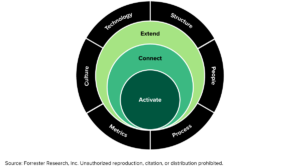How CX Teams Must Adapt To Steer A Journey-Centric Transformation
Tasks And Responsibilities To Activate And Evolve Journey Centricity
Need a menu of tasks that customer experience (CX) teams can assume to steer a journey-centric transformation? Find it in our new report!
Embracing journey centricity often takes years. Firms pass through three phases — activate, connect, and extend — and transform six operational levers at each one. CX pros play a vital role in kick-starting the transformation and guiding their firms. They transform six operational levers at each phase to become journey-centric, taking on responsibilities like skills building, stakeholder management, governance, and scaling.

CX Teams Must Adapt As Their Firm Progresses Through Each Phase
Some tasks, such as vision setting, prioritization, and journey mapping, remain the CX team’s purview throughout the journey-centric transformation. But CX teams must also adapt as their firm progresses through each phase.

You Can Also Select From A Menu Of Tasks By Lever And Scope
CX pros don’t just work in the CX department. Their skills vary by region, and they have different scopes and org structures which might be enterprisewide, centralized, or decentralized with central coordination. CX teams can:
- Pick tasks that address imbalances for specific levers. Tasks like setting up a journey atlas help advance the structure lever; tasks like journey mapping facilitation and validation, as well as setting up guidelines and playbooks for roles, journey prioritization, methodology, KPIs, meeting cadence and structure, and dashboards, help advance the process lever.
- Pick tasks based on scope. Tasks that CX teams perform can be organized into themes like activation energy (for teams kick-starting journey centricity but lacking a mandate for a full-scale transformation) and skills, methods, and tools (for teams that have a more consultative role within the organization). Data, insights, and measurement-focused teams can pick from tasks in the journey success theme. Tasks can also be clustered around themes like governance (for organizations that are geographically dispersed), internal communications (to drive mind shifts and address challenges with executive buy-in), and future-proofing and scaling (for more advanced and innovation-focused CX teams). CX teams should take stock of existing capabilities (e.g., customer research, design thinking, vision and strategy, and measurement) to advance journey centricity.
If you’re a Forrester client, check out this brand-new report, How CX Teams Must Adapt To Steer A Journey-Centric Transformation. You can also reach out for a guidance session or inquiry with me.
